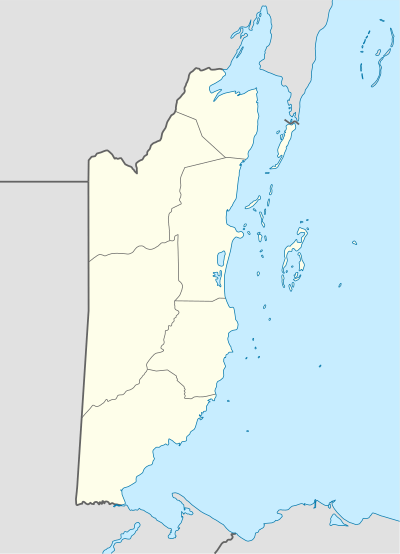Half Moon Caye
 The windward shore of Half Moon Caye | |
 Half Moon Caye | |
| Geography | |
|---|---|
| Location | Lighthouse Reef |
| Coordinates | 17°12′17″N 87°32′11″W / 17.2047°N 87.5364°WCoordinates: 17°12′17″N 87°32′11″W / 17.2047°N 87.5364°W |
| Adjacent bodies of water | Caribbean Sea |
| Area | 0.168 km2 (0.065 sq mi)[1] |
| Length | 0.8 km (0.5 mi) |
| Width | 0.2 km (0.12 mi) |
| Administration | |
|
Belize | |
| District | Belize District |
Half Moon Caye is an island and natural monument of Belize located at the southeast corner of Lighthouse Reef Atoll.[1][2] This natural monument was the first nature reserve to have been established in Belize under the National Park Systems Act in 1981 and first marine protected area in Central America. This is also Belize's oldest site of wildlife protection since it was first designated as a bird sanctuary in 1924 to protect the habitat of the red-footed booby birds.[3]
Geography
The caye is located about 50 miles (80 km) south-east of Belize City at the southeast corner of the Lighthouse Reef Atoll, which is the outermost coral atoll of Belize's three atolls.
World Heritage Site
Half Moon Caye Natural Monument is part of the Belize Barrier Reef Reserve System World Heritage Site which was established on December 4, 1996, by the United Nations World Heritage Committee after they formally adopted seven marine protected areas along the Belize Barrier Reef and its adjacent atolls under the United Nations Educational, Scientific and Cultural Organization (UNESCO) at their meeting in Mérida, Mexico.[4]
The nature reserve is managed by the Belize Fisheries Department and co-managed by the Belize Audubon Society.
Significant features
- The Half Moon Caye Wall is a well known dive spot called the “6,000 feet of vertical abyss”. Within this structure, divers will be able to see a diversity of marine life including corals, garden eels, sponge formations, eagle rays, sea turtles and groupers.
- The littoral forest, composed primarily of the orange-flowered siricote tree, provides an endangered and fragile habitat that supports one of the only viable breeding grounds for the red-footed booby colony in the western Caribbean. The booby colony supports the forest’s stability by providing guano as fertilizer. It is also a habitat tor the endemic Belize leaf-toed gecko (also known as the Belize atoll gecko) and Allison's anole lizard.[3]
- The south eastern part of the island serves annually as a sea turtle nesting ground from May to November for the loggerhead, hawksbill, and green turtles, all endangered species.[3]
References
- 1 2 Belize Audubon Society (2008). "Half Moon Caye Natural Monument".
- ↑ Belize Tropical Forest Studies (2010). "Half Moon Caye Natural Monument". Biodiversity and Environmental Resource Data System.
- 1 2 3 Robinson, Julianne S. (October 2000). "Lighthouse Reef Atoll Conservation and Protection Project" (PDF). U.S. Agency for International Development (USAID) PROARCA/CAPAS. Retrieved 7 December 2015.
- ↑ "Belize Barrier Reef Reserve System". UNESCO » World Heritage List. UNESCO World Heritage Centre. Retrieved 30 November 2015.
| Wikimedia Commons has media related to Half Moon Caye. |